#father and son material
Explore tagged Tumblr posts
Text

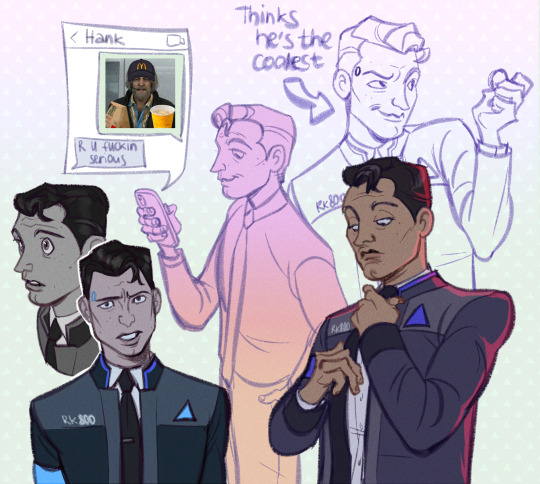
in dbh brainrot again
#I recently rewatched sean's playthrough and god#Im still in love with hank and connor's relationship#they are so#father and son material#I missed them#detroit become human#dbh#dbh fanart#dbh connor#connor rk800#hank anderson#connor#character design#character art#artwork#fan art
2K notes
·
View notes
Text
Every Boromir hater makes my enormous love for him grow stronger. Sorry you couldn't understand him, I get him tho and we're holding hands and the whole of Gondor is laughing at you
#lotr#boromir#tbh i think id actually have a good time chatting w a boromir hater if they knew and understood the material but still hated him#cuz most people who dislike this man do because of very shallow reasons#'he was upset looking down at narsil' one can only wonder why that has baggage for a gondorian and the stewards son#'he didnt accept aragorn at first' yea i bet when a dirty ass ranger claims the throne of a kingdom without having lived there#when your fam took care of it for several generations it doesnt feel super great and you Might be a bit upset and worried about it#'he tried to take the ring from frodo' despite disagreeing w the councils decision he still earnestly followed them to destroy the ring#and he only fell after weeks of traveling as the ring whispered to him threats of destruction#one that unlike the rest of the fellowship was already Actively happening and had been happening for a long time#you see ur cities fall and people die everyday as the 1st line of defense against ultimate evil and we tell you not to use a perfect weapon#while said weapon tells you yes it will fix everything just grab it go on boy#and echoes words your father has been pushing onto you all throughout#it feels like people just have no sympathy compassion or understanding for all he's gone through or for the power of the ring#deep breath. im ok#im normal about boromir and my heart doesnt shatter at every rewatch of his death#id have followed you my steward.
288 notes
·
View notes
Text
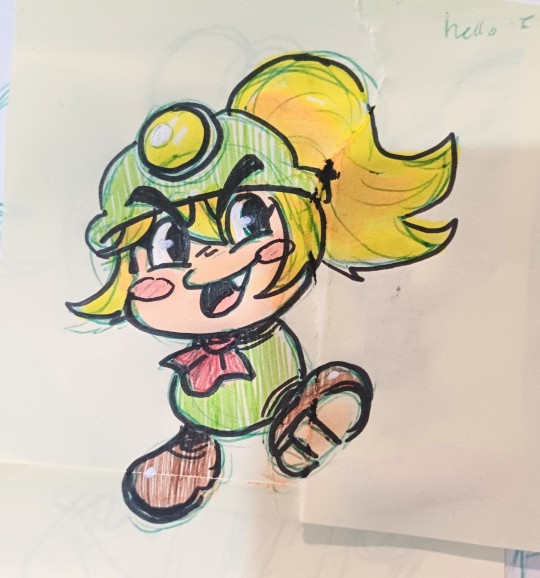
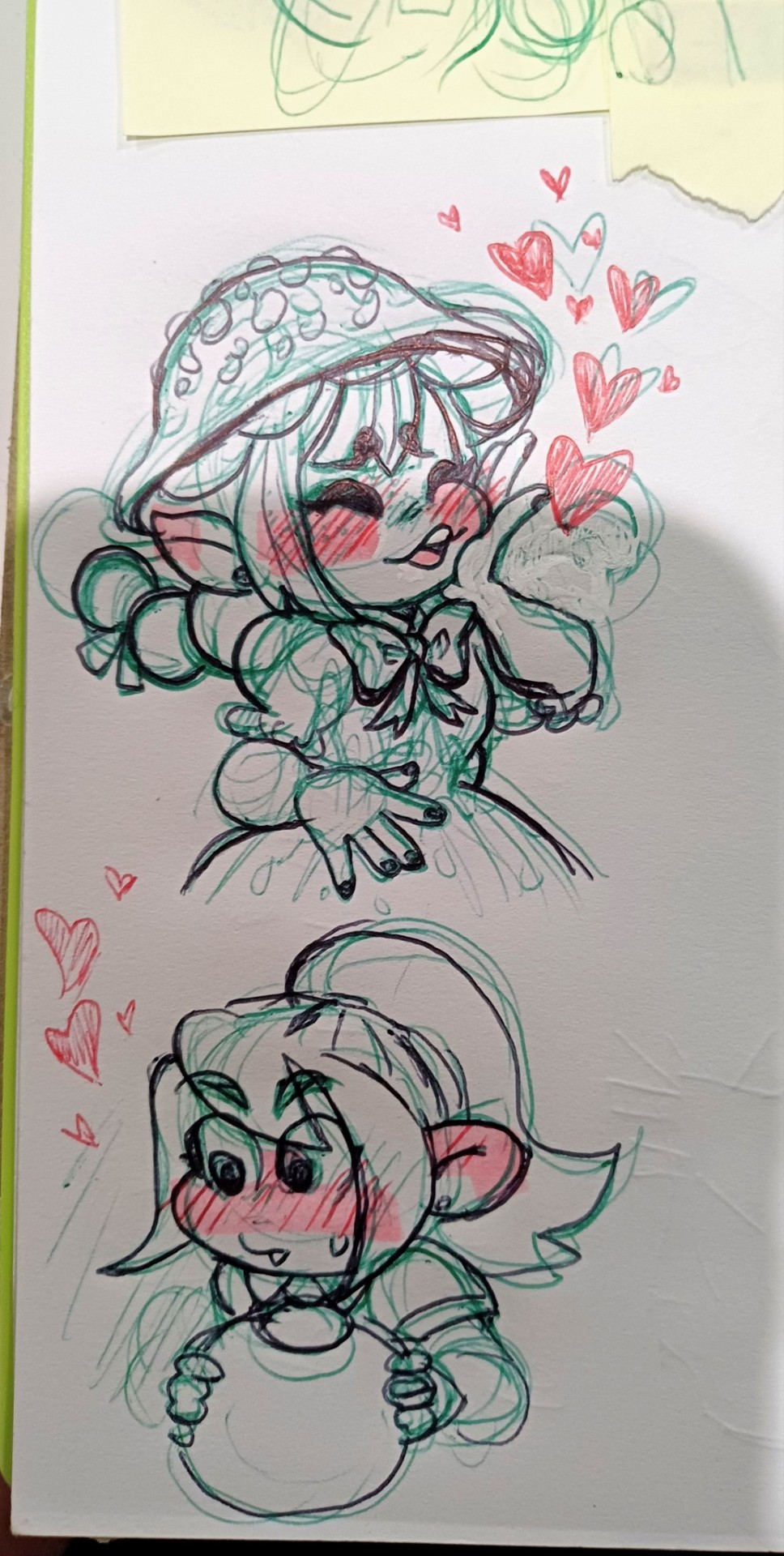


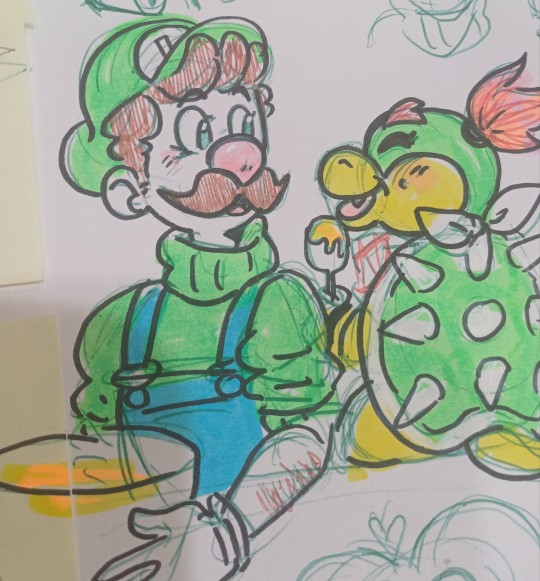
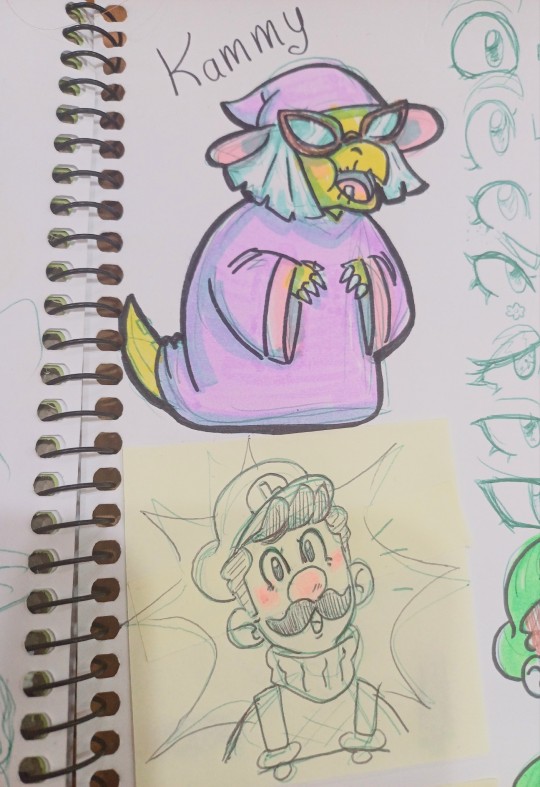
An entirely self indulgent super mario sketch dump
#mostly paper mario but also a luigi and bowser jr baking because father son bonding#paper mario vivian#paper mario ttyd#paper mario#paper mario the thousand year door#the thousand year door#ttyd#madame flurrie#kammy koopa#bowser jr#luigi mario#luigi#luigi my beloved#vivian ttyd#vivian paper mario#sketch#sketchbook#sketch book#artwork#pen sketch#doodles#materials used include:#bic pen#high lighters#just a white posca pen#and a felt tip for any brown
341 notes
·
View notes
Text
🐇Kojishoji Shippers how y’all feeling?!!🐙

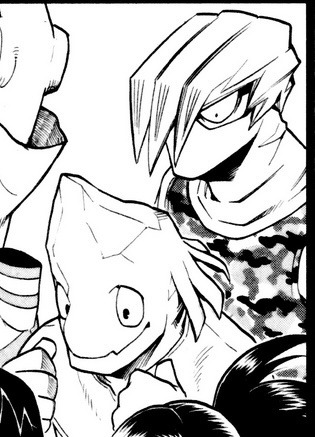




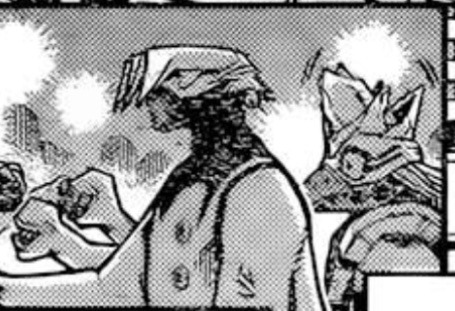
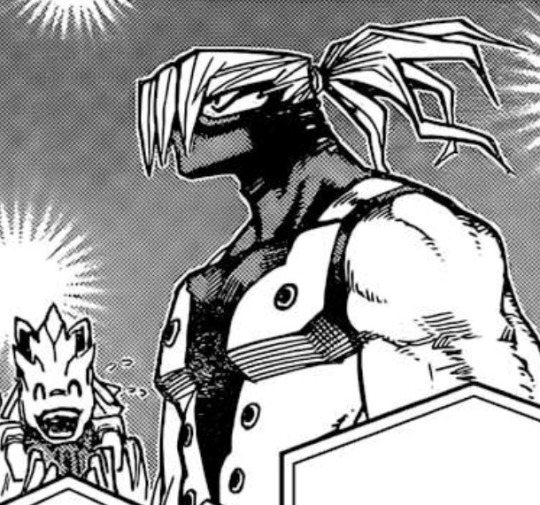
Bonus: The parallel between Koda parents and Koda/Shoji was definitely intentional🤭


🐙Also get someone who will look at you like Shoji looks at Koda🐙
#my hero academia#boko no hero academia#bnha#mha#bnha spoilers#mha spoilers#bnha manga panels#bnha chapter 430#mha season 7#class 1a#bnha ships#rare ship#mha shoji#shoji mezo#mha koda#koji koda#kojishoji#shoji x koda#Koda x shoji#the parallels#they deserve the world#they deserve to be happy#love their friendship#mainly platonic vibes but i can see the ship material#i don’t care if there not canon let me dream#lgbtq#they love each other#horikoshi knew what he was doing#thank you horikoshi#he his father son
149 notes
·
View notes
Note
oh my god youre right he is NOT normal about tobio
I KNOW!! AND THEN THE FANDOM GOT MAD AT ME FOR POINTING IT OUT.
Listen. I might have written a fic where Tenma molested his robot son while thinking about his dead one, but Tenma was the one who clearly wants to do it, like?? NOTHING HE DOES IN REGARDS TO HIS SON IS NORMAL. "He's grieving" can only go so far!!
#ask#alvie-pines#not main tagging so that the fandom doesn't cry about it again#tenmatom#the stalking and obsessive behavior is NOT how a normal father grieves#his trauma has reached a point where he wants to touch his son inappropriately#sorry i have to be the one to tell you but you should have gathered that from the source material
22 notes
·
View notes
Text
"Rhaenyra isn't the stepmother, she's the mother who stepped up!"

The HOTD writers themselves are hardly doing anything to support that narrative, so I take this rhetoric with a grain of salt. While I think, in some way, Rhaenyra does care for Baela and Rhaena....if I had to point out a motherly figure for them that could pose as someone stepping in Laena's place, Rhaenyra would not be it.
#house of the dragon#hotd#hotd critical#rhaenyra targaryen critical#baela targaryen#rhaena targaryen#this mainly just comes from my frustration with this fandom painting rhae as overly motherly toward baela & rhaena#making it seem like we had so much to go on for her being a good stepmother when it's really the bear minimum#there's more with rhaenys being there for them than with rhae--- both physically & verbally#even with scenes where she's with them: for baela it holds more of political means with her having a dragon and then using her to see corly#like sure she could be concerned about her well-being but it's definitely not on the same level as with her sons#don't even get me started on with rhaena bc that “be a mother to them” line had me 🤬#and her referring to her sons as hers and the pain of sending them away but not adhering to rhaena's emotional needs and feelings of inferi#rity--- like it didn't sit right with me especially when she couldn't even be bothered to hug her#i like to enjoy headcanons about their relationship but the canon material doesn't stray far either#rhaenys raised baela alongside her on driftmark she sought rhaena out when they met after so long#she advocated for rhaena to her husband over joffery--- she's their grandMOTHER that stepped up tbh#tbh i wouldn't really be rocking with my stepmom if she sought after & slept with my dad at my mom & stillborn brother's funeral#barely comforted my sister and i when we were injured in a fight (only her sons)#then got married to said father not long after said funeral...like i'd be pressed tbh!#dni if you can't have a collected conversation about this#rhaenys targaryen#(also just bc im a little critical of rhae doesn't mean i hate her in comparison to others she's not that bad tbh)
68 notes
·
View notes
Note
Question about Couya! Since she is a bastard what are the reasons about her being brought into the main family by her father. Was it genuine care for his child or a way to save face politically/socially? Is her birth mother alive? Do you think she would have had a better life growing up anywhere else?
This is in large part due to how cultural perceptions and legal punishment of adultery varies between male and female citizens, looped into the very strictly patrilineal kinship system.
By legal definition, the word for 'adultery' applies only to situations where a man has an affair with a married woman, or a married woman has an affair with any man. Other forms of affairs (eg a married man having an affair with an unmarried woman) are wrapped into a broader set of sexual misdemeanors and aren't often charged or punished in practice, and the punishments are comparatively minor (if an unwed woman's father pursues charges, the man in the affair is likely to just pay a fine). On a social level, extramaritial affairs in general are certainly not Approved of and seen as lowly and dishonorable, but the average response is significantly less harsh/more willing to entertain Nuance with men than with women.
In this society there's differentiated shades of bastardry depending on the contexts of the child's birth, as well as a distinction for 'nameless bastards' (has not been claimed by their biological father or maternal grandfather, or claimed in adoption).
a) A child born to an unmarried woman via an unmarried man: non-issue for father, potentially serious social harm for the woman (especially if she has never been married and expected virginal, much less severe as a widow or divorcee). The child will not be notably disadvantaged in of themselves (their status will depend more on whether they are claimed and thus provided the social security of a family patriarch), the father will experience no hard disadvantages in claiming them.
b) A child born to an unmarried woman via a married man: mild sexual misdemeanor for the father carrying levels of social shame, even more serious social harm for the woman (often framed as not just loose but a manipulative Seductress of a married man). The child might experience minor to moderate social disadvantages, the consequences of the father claiming them are purely social and will not typically be severe. (Couya is this)
c) A child born to a married woman via an unmarried or married man: both man and woman have committed a crime and can be severely punished. The biological father can technically claim the child but will be disincentivized from doing so. This is the form of bastardry most comparable to the conventional definition, in that it is heavily stigmatized and has effects on concerns of kinship and inheritance.
In addendum to this, if the adulterous wife's legal husband claims the child, this may be punishable if determined to be active concealment of adultery (which is also a crime), and has EXTREME social consequences either way. (Either you're a cuckold too stupid to notice that your wife has been skipping out on you, or you're a MEGAcuckold adultery-accessory willingly rearing another man's child after being horribly shamed by him).
(This is separate from adoption- a man who marries a woman with an unclaimed child after the fact (whether it was a product of adultery or just a general out of wedlock birth) and claims the child is an adoptive father, he is not concealing adultery or being cuckolded.)
A child born in an affair can be considered an heir to their biological fathers (descent and kinship is fully patrilineal and on a Basic level it doesn't matter who the mother is), and can very smoothly and legally be claimed when the affair was not considered criminal adultery. The concern on that front is social perception rather than material legal consequences or kinship issues.
Couya's birth mother was an unwed servant working as a housekeeper for her father Saizen, so the Crime of adultery did not take place. It would be considered a minor sexual misdemeanor, and the woman's father was not about to pursue charges against a nobleman who could Ruin him (and had also formally expressed that he would claim the child, which meant he would not be saddled with a nameless bastard granddaughter). So the concerns here were entirely social.
The affair might have started beforehand but the pregnancy that produced Couya occurred after his wife's third viable pregnancy ended in the premature birth of a underdeveloped boy deemed necessary to euthanize (and tbr would Not have survived either way). This was after Livya Haidamane had a couple early term miscarriages, two viable but very difficult pregnancies wherein one child was very weak and sickly for the first several years of life, and struggled to conceive every time. A lot of people are going to be at least a little sympathetic to a married man having an affair and claiming a bastard in this context. It's definitely ideal and practical to have more than two children, and his wife (while not outright infertile) clearly could not reliably bear healthy children. (The average response is going to be "Well he shouldn't have done it but like, I get it")
Couya being claimed by her father was a mix of genuine care and saving face. Initially it was MUCH more the latter than the former. Saizen made attempts to hide the servant's pregnancy and to keep his own wife out of sight during the late term (to prevent the baby appearing after his wife had been seen Extremely not pregnant). But there's some levels of care involved, he could very easily have fired the pregnant servant and had nothing to do with his bastard and she would have no recompense whatsoever. The choice to keep and claim the baby and ensure its entrance into the world bore as little social scrutiny as possible is an act of care for his own progeny.
This was Not an act of care for Couya's birth mother (beyond the fact that concealing her pregnancy would benefit her in hiding that she is not only Not a virgin prior to marriage but had a child). She probably would have been about 17-19 at the time and was fired a few months after giving birth, and most likely never saw Couya again after this point (if she did, it would most likely be in the context of seeing her as an adult Odonii in public and noting her to look Scarily familiar). She has an Okayish chance at still being alive, she'd be around 50 (and a person who survives the high infant mortality and birth casualty rates stands a good chance of hitting their 60s), though she could very well be a casualty of the drought+famine.
Whether or not Couya's life would have been better is kind of a mixed bag. She had an awful fucking childhood in large part because her adoptive mother Livya Haidamane hated her. (Livya was ultimately a pretty horrible person but not just like. An Evil Bitch. She had A Lot going on and Couya was a living breathing insult to her and reminder of like, every one of her dashed hopes and dreams). Couya is also autistic and presented very intense symptoms as a child in a society that is Not equipped for a mass-understanding and support of cognitive differences. But she still did have an immensely privileged life with profound physical/economic levels of security inaccessible to the vast majority of people in this region, including her birth mother. Saizen also actually Liked her and cared about her, he just wasn't a routine physical presence in any of his children's lives.
Had she been left with her biological mother, she would be in a very disadvantaged situation as a nameless bastard to an unwed mother. Her biological grandfather may or may not have been willing to claim her, and her mother would have great difficulties in finding a husband (which is ultimately necessary for the security of women in this society). I think her mother was a relatively kind person but not like, a perfect angel. She would probably have complicated feelings about her bastard daughter, especially one whose very existence materially disadvantages her and was very, very difficult as a child. So this probably would not have been a good situation for Couya either.
If you broaden the question to ANY other family completely divorced from the circumstances of her birth, yeah it definitely could have been better. But in her case it's like either "Life of grotesque socioeconomic privilege but in an abusive household" or "Life of profound socioeconomic disadvantages in a household that Probably wouldn't have been this abusive but certainly wouldn't be healthy". There wasn't really a good option for her.
#I think I've overemphasized the Social consequences of adultery/bastard children and underemphasized that committing#or abetting adultery is Illegal and punished pretty severely#But in this case nothing about Couya's birth was considered 'adultery' by societal definition and in being formally claimed by her#father (with no reason to question that he Is her father) the rest of her family is obligated to treat her as full kin wrt familial#obligations and inheritance#Livya Haidamane was also expected to fully behave as her mother and like. This happened after suffering through very difficult and#traumatic pregnancies. Delivering a premature son and watching him be euthanized. Then her husband IMMEDIATELY#knocks up a servant and most people around her are kind of like 'yeah not a great thing to do but I get it' because she was Only able#to push out two relatively healthy kids. And then she has to treat the Living Embodiment of all this as her daughter who happens#to also be an extremely difficult child.#This kind of changed the whole trajectory of her life and was not something she had Any means of processing or coming to terms with#and instead Coped with by severely emotionally abusing said child and pitting her against her disappointing son while idolizing her#eldest daughter thus contributing to the production of three really fucked up adults.#Also note that 'claiming a child' overlaps with but is not the same thing as 'raising a child in your household'#A claimed child takes the father's family name and is considered legal kin. This has very practical applications and means that#you and the rest of your family have lifelong legal and honor-based familial obligations to this child.#A father (or grandfather) may deign to raise a bastard without claiming them which can provide physical security but does not#have Kinship and its structure of familial obligations backing it. So these two situations can be materially different and affect#the trajectory of a child's life.
37 notes
·
View notes
Text
sometimes I'm like lalala it's so fun here but then I see dadbastian comments under a evidently sebaciel post/art and wonder how deep the delusion is
#look interpret source material how u want#but I swear to god he can be balls deep into British aristocracy#and then 'like father and son 🤧❤️'#be for real 😭😭#sebaciel#ik the same logic can be applied right back but let me be annoyed for a bit
17 notes
·
View notes
Text

#karl marx#marxism#marx#marxism leninism#marxist#socialism#communism#biography#historical materialism#dialectical materialism#leftism#leftists#father#father son#revolution#communist#history#trier#university#humanity#good#class struggle#class consciousness#working class#philosophy
9 notes
·
View notes
Text
You know what, not only does AFO have his suits in different shades of black, but I bet each one has a vest and tie to come with it specific to the occasion he's wearing it for.
#like a vest to wear to go meet your future adopted son's father you must definitely had dinner with#or 'I'm here to take your kneecaps or your quirk which one should I take'#something like that#also black suits with a color sheen to it like your can see purple shift on the material#just kiya's thoughts#bnha#mha#boku no hero academia#my hero academia#afo#all for one
25 notes
·
View notes
Text
i say this with all my love as a kuroshitsuji fan: gatekeep kuroshitsuji fr
#kuroshitsuji#we have enough of ppl ignoring the source material and insisting it isnt a yaoi and ppl insisting sebastian and ciel have a father/son r/s
27 notes
·
View notes
Text
OMG
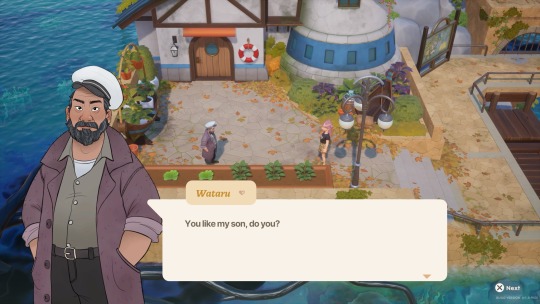
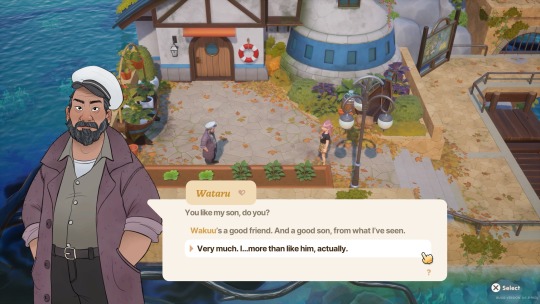
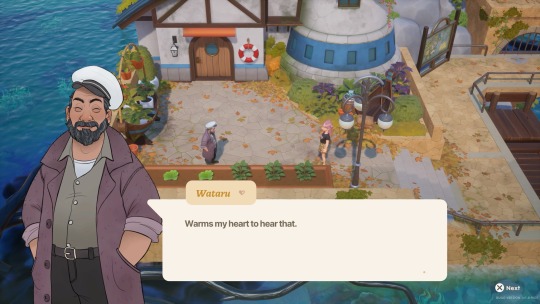
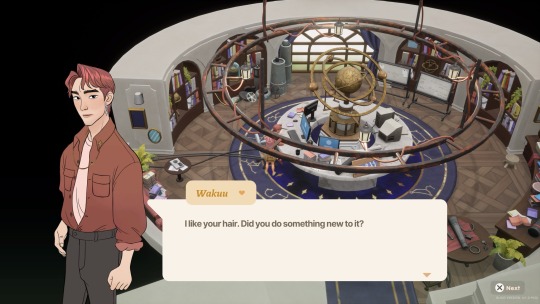
TWIRLS HAIR GIGGLING
#— ❁ nerdiel has no braincells#coral island#coral island wakuu#wakuu#coral island wataru#i got fathers approval to marry his son#i’ve only been asking since day 1#and wakuu just gave me a compliment for the first time#hubby material right there#i love my stargazing nerd
51 notes
·
View notes
Text
Being in fandom is like 1/3 of you guys ship these guys 1/3 of you think they’re father and son 1/3 of you are convinced they hate each other wayyy more than they do in canon and me? I feel like they’re fucking coworkers
#I have two very specific character dynamics in mind#1) he is his BOSS and his MENTOR they are not hooking up#2) they are not father and son and actually I think the ‘son’s’ dynamic with his real father figure is much more compelling#3) they do actually get along. they get along in canon. they argue but they do get along please return to the source material
2 notes
·
View notes
Text
Cienie's take on Mandalorian Culture: Arasuum, the God of Death, not Sloth #2
The Funeral Rites of Taungs and later Mandalorian Warriors. <> Kad Ha’rangir and Mandalorian traditional weapons (part 1 — part 2 — part 3 – part 4 – part 5) <> Arasuum, the God of Death, not Sloth (part 1 — part 2 — part 3 — part 4)
The first part was an introduction to my theory that Arasuum is not the god representing laziness, but death. I based my reasoning on the Mandalorian language that distinguishes between stagnation and laziness, as one word is not derived from another but also pointed out a visible correlation between gods names and their roles, in which laziness does not fit what the sources provided so far for Mandalorian gods. Thus laziness as Arasuum’s attribute seems to me more like modern interpretation than the original meaning behind the myth.
Establishing those two important nuances, it is time to look closely at the source material and their nature. In advance, I must warn that this part is focused on examining the sources as much as the religion itself, as text critical analysis is a natural part of widely understood research.
Keeping in that mind, let’s talk about source material.
Ancient Mandalorians were presented as religious society that once worshiped many gods before the war became a divine itself - the claim dates at least to “History of the Mandalorians” from Star Wars Insider #80, 2005. From 2005 to current day, there are three main sources that influenced fandom’s idea of Arasuum and his role in mandalorian mythology:
Mandalorian: People and Culture [Star Wars Insider #86, 2006]
Industry. Honor. Savagery: Shaping the Mandalorian Soul [The Essential Guide to Warfare, 2012]
Death Watch Manifesto [The Bounty Hunter Code, From Files of Boba Fett, 2013]
The Star Wars Insider’s article was written by Karen Traviss, whose Republic Commando book series shaped and popularized the modern Mandalorians[1]. This piece was published on February 21, 2006, which chronologically predates Republic Commando: Triple Zero, released on February 28, 2006. A lot of presented here ideas were either already part of the author's previous work (Hard Contact book and Omega: Targets short story) or will be exploited more in further novels. Understandably then, Mandalorians: People and Culture is more of an introduction to the world of Mandalorians than an ultimate guide - though a great chunk of presented in article material built the ground for writing of other authors and fans alike, it is hard to miss how it contradicts itself on some vital matters.
The article starts with the opening quote from in-universe “Mandalorians: Identity and Language”, published by the Galactic Institute of Anthropology:
In five millennia, the Mandalorians fought with and against a thousand armies on a thousand worlds. They learned to speak as many languages and absorbed weapons technology and tactics from every war. And yet, despite the overwhelming influence of alien cultures, and the absence of a true home world and even species, their own language not only survived but changed little; their way of life and their philosophy remained untouched; and their ideals and sense of family, of identity of nation, were only strengthened. Armor is not what makes a Mandalorian. Armor is simply a manifestation of an impenetrable, unassailable heart.
This passage gives us a sense of what the Mandalorians are - or rather how they are seen by the unnamed author(s). But this is a very romanticized if not outright idealized description, based more on wishful thinking than a “facts” (lore) itself.
For one, Mandalorians’ way of life did not remain untouched, as they changed from independent military force (Mandalorian Crusaders and Neo-Crusaders) into people mainly engaged in mercenary work due to lost Mandalorian Wars (3976-3960 BBY) and if we include much later New Canon, they changed from warriors to pacifist (738 BBY). Majority of Mandalorians’ inner conflicts were in fact about what Mandalorians should be, because there was no common, universal identity all people could cling to anymore. And yes, the majority of (Legends) Mandalorians saw themselves as warriors, but that was not enough to avoid schisms and civil wars.
To name the major examples, the first real friction happened just before and during the Mandalorian Wars, between traditional Crusaders and the New-Crusaders whose philosophy and purpose deviated from the universally accepted norms. Among those “oddities” was establishing color-themed armors and using them as official ranks or mass-forcing people into the Mandalorian army - something that more traditional Mandalorians like Mandalore the Ultimate or Gummig did complain about through the comics series of KotOR and spin-off sources. The Knights of the Old Republic Campaign Guide (2008) openly states that

The traditional Crusaders do not proselytize; rather, they attract others to their cause through the examples they set. Veterans see the later Neo-Crusaders movement, which actively converts outsiders in its hurry to conquer the galaxy, as a perversion.
After the war, a great number of Mandalorians became mercenaries and Canderous Ordo needed decades to rebuild the sense of warrior honor and reunite scattered Mandalorians under his banner. For his effort, he earned the name Mandalore the Preserver. And yet the discord between warriors following the old traditions and those turning into mercenaries or outright bandits preying on the weaker grew stronger. This cultural shift has never been fully merged back and so three to four centuries later, we have another ideological conflict between Mandalorians, this time those following Mandalore the Avenger (Shae Vizsla) and Heta Kol, the Field Marshal of Hidden Chain. The clash again came down to the mercenaries vs warriors/crusaders mindset that we could sum up with Heta Kol’s quote:
In Shae Vizla, I see only hypocrisy. She has driven out those who oppose her view, yet she has remade the Mandalorians into servants of anyone who pays her enough credits--no matter what they believe. Where is the honor in that?" [The Old Republic game]
Similar conflict happened decades before Clone Wars, between True Mandalorians under Jaster Mereel and later Jango Fett’s leadership and Death Watch led by Tor Vizsla. Depending on the sources, Jaster Mereel either saw Mandalorians just as highly paid soldiers (as stated in Jango Fett: Open Seasons) or brought reforms to bring Mandalorians back to the more honorable ways (as presented in majority of tie-in sources), while Tor Vizsla wished to bring back Mandalorians to their conquering galaxy roots[2].
If we include New Canon, the mandalorian conflict takes even more drastic shape, this time between exiled warriors and those who renounced their war culture for pacifism.
Which proves that in the main historic eras presented in lore, Mandalorians may share the same skills, be part of the same war culture, yet there is no “only right one” identity or philosophy that unites all people and during the inner conflicts, a great chunk of Mandalorians will consider their ideological opponents as “dar’manda”[3], or traitors regardless if they follow cultural norms or not. The Mandalorian style of life has changed and changed in a way that left their culture fractured and torn between seeking independence and rebuilding the Mandalorian Empire or accepting the life of mercenaries or even rejecting both ideologies for non violent, peaceful life.
A similar thing may be said about language, because the way people speak naturally evolves with passing time and is a reflection of their culture and historical period they lived in. For Mandalorian language to remain the same for such a large period of time - five millenia, as quote states - its speakers would need either to die out or at least live in isolation, cut off from the rest of the galaxy. Which in both cases we know is not true.
We need to remember that the post-Mandalorian Wars era is a time in which the original Mandalorians (Taungs) died out, replaced by human and non-human people adopted into culture before and during war. As then-current Mandalore the Ultimate noted himself, Mandalorians faced problems they never before had, including the new wave of recruits and not enough time to teach them their culture:

“So many new recruits. Different species, different armors, different languages - and not enough time to learn our ways”. [Knight of the Old Republic, #20]
Which is a valid reason to assume that original mando’a at some point was influenced by new recruits’ native languages, especially Basic. Because if there was no time or opportunity to teach a mass of people (often forced into the Mandalorian army against their will), then naturally all the gaps in linguistic knowledge will be filled by things “newcomers” actually knew and understood.
Going further, The Mandalorians: People and Culture provides information that:
Mando’a is predominantly a spoken language, and contractions and pronunciation variations occur much as they do among Basic speakers
and that
The infinitive ends in -ir, -ar, -ur, -or, or -er. Removing the “r” usually produces the stem, e.g.: jurir - to bear or carry. Sometimes an apostrophe separates the terminal vowel, to indicate the slight glottal stop of some Mandalorian accents. This apostrophe, known as a beten, or sigh -- as in Mando’s -- can also indicate breathing, pronunciation, or dropped letters. So ni juri kad (I carry a saber) or even ni jur’kad is a correct as ni juri kad in some communities.
or
Spelling and punctuation have optional forms so it’s hard to get it wrong. What other species might take for sloppy grammar, Mandalorians embrace as the right of the individual Mando’ad (son or daughter of Mandalore) to add their own touches to their language, much as they customize their armor.
If we agree that mando’a words can be pronounced however each Mandalorian feels like, then it is natural the language may vary from one speaker to another, and with passing time creating specific dialects for individual clans or even the whole region. For example, Concord Dawn is part of the Mandalorian Sector. The article noted
[Mandalorians] are still predominantly human, and a large percentage of the population shows genetic markers typical of the peoples of Concord Dawn and nearby planets. Although there is no true Mandalorian ethnic type, the prevalence of common gene clusters indicates that specific populations were either absorbed by the Mandalorians or joined them.
and yet, Concord Dawn, despite such historical and cultural strong ties to Mandalorians, has its own dialect[4] that is apparently still close enough to mando’a to be understand by Mandalorians however it has its own distinct words that make communication difficult.
“It wasn't Mando'a, but it was close enough for any Mandalorian to understand”. (Republic Commando: Order 66)
&
Commander Bacara was originally trained by one of the few non-Mandalorian instructors, an ex-Journeyman Protector named Cort Davin from the Concord Dawn system. [...] Bacara found it difficult to converse in Mandalorian with his brethren as he learned the peculiar dialect of Concord Dawn, which used words like “tat” instead of “vod” for “brother”. (Guide to the Grand Army of the Republic, published in Star Wars Insider: 84)
The moon of Mandalore, Concordia, apparently also has its own dialect[5], as mentioned by The Clone Wars in The Mandalore Plot episode:
Satine Kryze: He was speaking in the dialect they use on Concordia, our moon.
A dialect that the Duchess of Mandalore recognized easily and was capable of understanding and speaking it(?).
Additionally, the Complete Star Wars Encyclopedia’s entry for mando’a states:

At its core, Mando’a was a spoken language, because many different groups spoke it with enough subtle variation that writing it down became problematic [...].
As much as I agree it is impressive for Mandalorians to cultivate their culture for millenia despite many historical setbacks (including devastating military defeats) that influenced their political-economic standing in the galaxy, saying that language did not change for such a long period of time is both wrong and surprising for an in-universe academic claim officially published by the Galactic Institute of Anthropology.
I assume the author’s intent was to praise Mandalorian’s unshakable sense of identity. However, looking at it from the perspective of time and expended lore, this statement puts into question not Mandalorian history but the Republic (galactic)’s knowledge about the Mandalorians. It does not help that we have no time frame in which the in-universe academic text was written, as in how out-dated could be the source.
The main part of the Mandalorians: People and Culture is not free of inconsistency and some parts contradict each other within the same article. This is the most seen with gender norms, a topic to which we will soon come back in regard to Mandalorian religion.
At the start, the article points out unknown origin of Mandalorians
[...] they’re probably not even the original Mandalorian race. Anthropologists disagree about their roots; did they begin as humans or, as a few academics still claim, a gray-skinned non-human species? Whichever theory you find most convincing, they became a species of predominantly human nomadic warriors
while the “as a few academics still claim” statement sounds dismissive toward original Mandalorians (Taung species) and the connection between them and now predominantly human Mandalorians[6]. A connection that is confirmed in lore since at least 1995. This uncertainty of historical background acknowledged by the author puts into question further information about their religion.
Let’s take a look at the paragraph of Mandalorian religion:
Mandalorians were once intensely religious but disillusionment with the old fanaticism and worship of war itself gave way to a far less supernatural belief system among modern Mandalorians. They now regard creation tales, such as Akaanati’kar’oya (The War of Life and Death) as parables to illustrate a deeper philosophical meaning rather than literal supernaturalism. The stars were mythologized as fallen kings of Mandalore, and there are tales of the mythosaurs, but the pragmatic and skeptical Mandalorians look for allegory in these stories. The manda - best described as a combination of the collective state of being, the essence of being Mandalorian, and an oversoul - is not viewed as a literal heaven. Traditionally, the Mando afterlife is seen as a plane of spiritual energy in constant conflict between stagnation, and the opportunity for change brought about by destruction - a parallel with modern theories of cosmology. In Mandalorian myth, this conflict is symbolized by the eternal war between the sloth-god Arasuum - the personification of idle consumption and stagnation - and the vigorous destroyer god Kad Ha’rangir, who forces change and growth on the universe. Every Mando warrior who dies is said to add to the army of the afterlife, defending wives and children living in its permanent, peaceful homestead - the only place Mandalorians believe they can ever reach a non-transitory state of existence.”
The change from deeply religious society to less concerned with gods and religion feels like a natural order of things, especially when we remember that the original Mandalorians died out around four thousands years ago and their legacy was influenced by many factors since then. However, the aforementioned uncertainty of historical background for Mandalorian culture forces us to ask, to whom and which era refer to the term of traditional belief? By “traditionally” does the author here mean the already predominantly human Mandalorian culture or consider it as something passed down by “unknown” predecessors? Should we see the faith in Arassum and Kad Ha’rangir as the original religion practiced by Taung!Mandalorians or something that was created by an influx of human and other alien species that dominated the culture at some point? And it is not just a question related to Arasuum and Kad Ha’rangir, who to this day are the most prominent gods we know about but also to the concept of afterlife itself.
For one, Arasuum and Kad Ha’rangir are said to be part of the same myth, the Akaanati’kar’oya that means The War of Life and Death. Since Kad Ha’rangir is connected to growth, change and vigor it feels natural to associate him with Life, as those attributes represent the nature of living. If we agree that this god represents Life, then it is logical to assume Arasuum’s connection should be to Death, the opposed force. Arasuum name literally means stagnation and from it comes the word arasuumir - to remain the same, so this is one attribute we have no reason to question about him. However, the author calls Arasuum also the personification of idle consumption, and at first look this may sound weird, as idle or not, consumption itself is part of living. That way, both gods are tied to an aspect of Life, while the myth supposedly presents them as opposites forces, the Life and Death.
But, as the paragraph explains, Mandalorians believed that afterlife mirrors their mortal life - wives and children are living in its permanent, peaceful homestead, defended by warriors. Thus we could theorize that Arasuum’s “idle consumption” may refer to those who after death became part of “homestead” and choose(?) peace over serving in the afterlife army.
At the same time, the text presents us two separate ideas of the afterlife. One, mentioned above, mirrors mortal life. The other is a concept called MANDA, “best described as a combination of the collective state of being, the essence of being Mandalorian, and an oversoul - is not viewed as a literal heaven.” As the article stated, at some point Mandalorian people changed from a deeply religious society to one disillusioned with supernatural beliefs and that modern Mandalorians regard mythology as “parables to illustrate a deeper philosophical meaning rather than literal supernaturalism.” A change that has reflection in their funeral rites[7]. Thus we can theorize that afterlife mirroring mortal life is older than the manda itself that may be even unknown to original Mandalorians (Taungs). What brings us back to the vital questions: what era and which historical Mandalorian people fall under the “traditional” term?
This is indeed an important question, because of Mandalorians: People and Culture’s inconsistency, especially with the gender norms. For example, in paragraph MANDALORIAN SOCIETY, article claims
There is no gender in the Mandalorian language. This mirrors the equal status of men and women and the general flexibility of societal roles, despite what appears to many to be a traditional division of tasks along gender lines.
yet
Men are expected to be warriors and to raise and train their sons to be the same. Women maintain the home wherever the nomads happen to travel, and raise daughters. But women also are expected to have the combat skills of a man in order to defend the homestead when men are away. Women also fight alongside men on battlefront. If they have no dependent children to care for, they're expected to share the responsibilities of defense and warfare."
or
If the first child is a son, parents may wait eight years before having another child so that the first is old enough to accompany his father and be trained as a soldier for five years until he reaches adulthood at 13. Then his father is free to train a younger son. At 13, both girls and boys undergo a rite of passage in military and survival skills that makes them legally adults. If the firstborn is a girl, the couple may try for a son soon afterwards. A daughter will usually stay with her mother until she marries. But if a couple has only daughters, the girls will be trained as warriors by their father exactly as boys would be. Boys learn their earliest lessons from their mothers before the age of eight, so her fighting skills are critical; a couple pledges to raise warriors, and this is a joint commitment
which is far from gender equality (something mentioned by author also in her book series), as girls are treated as second-rated members of family compared to male descendants, while there is much more demanded from women than from men - to take care of children and train them nevertheless of their gender (while men should focus on sons first and foremost and may not be involved in their daughters’ training IF they already have a male descendant), maintain and protect home, be skilled a fighter with expertise in military and survival skills - even if it is boys that should be educated by both mother and father in combat, while girls may be trained just by mother and usually stay with her until marriage. A mother that is supposed to maintain the home (staying behind) while father takes sons with himself.
This statement[8] reflects traditional afterlife presented in the same article but makes little sense from the perspective of lore. Because we do in fact have a chance to see Mandalorian family dynamic during Mandalorian Wars, an era in which Taungs were still around. Knights of the Old Republic: War (2012) introduced us to Ko Sornell, a female Devaronian, who raided basilisk droid with her young son into battle

and who in general was deeply involved with ongoing military operations as warrior and comm specialist and simultaneously raising her children on frontlines


while there is no information about her husband's military position; we do see them together during mission - on one frame - standing arm to arm and that is all. As the couple together raised their children on frontlines, and Ko Sornell joined another mission instead of staying with her family in the detachment on Phaedacomm (thus being far away from the makeshift house for at least a few days)

until the comics again presents her with family (the last 5th issue),

it's logical to assume husband was the one that took care of their younger children[9] in the absence of their mother. Alternatively, children were under another clan member’s care when both parents were involved with a special mission on which they could not bring their kids.
What is even more interesting, Zayne Carrick - an outsider - upon meeting the Devaronian family pointed out that in the Devaronian culture, women stay at home with children while only males wander through galaxy.

and was assured by the Mandalorian family they indeed are fine with being nomads and raising children on the frontline.
This supports the statement of Mandalorians: People and Culture that “a couple pledges to raise warriors, and this is a joint commitment” but it undermines the division of adult responsibilities and the different treatment of children based on gender alone. Because a mother is not by default relegated to defending a homestead even though there are children under her care.
This is further backed up by Knights of the Old Republic Campaign Guide’s description of Mandalorian Crusaders
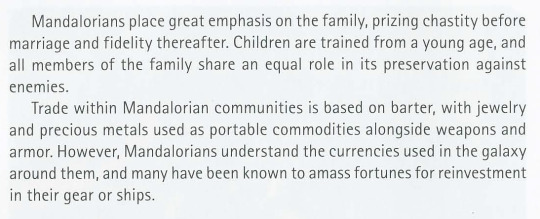
Mandalorians place great emphasis on the family, prizing chastity before marriage and fidelity thereafter. Children are trained from a young age, and all members of the family share an equal role in its preservation against enemies
and The Old Republic Encyclopedia (2012):

CLAN SOCIETY Mandalorian society operates with a minimal and largely informal power structure. Every Mandalorian is a member of a clan, either by birth or recruitment. Although different clans often disagree and even fight one another, they treat their own members like family, regardless of whether they’re related by blood ties or oath. Other than the clan chieftain, members have no official ranks or positions unless organized into a fighting unit where chain of command has a valuable place. Each man or woman is expected to contribute however they can, with those who achieve great things gaining increased respect and new responsibilities. Although clans may have ties or rivalries with other clans, there is no formal hierarchy. All chieftains report directly to the Mandalore The families of Mandalorians are close-knit and remarkably affectionate, despite the culture’s propensity for violence. Marriage is considered a lifelong commitment, and both biological and adopted children are raised with equal love. Sons and daughters are raised as warriors, as gender has little bearing in Mandalorian culture, so much their language hardly distinguishes between male and female.
If the Mandalorians in the twilight of Taung hegemony and relatively shortly after their extinction are presented as those who treat their sons and daughters as equally valued members of the community, then we should ask what caused such discord between this image and the one presented in Mandalorians: People and Culture. If we agree that the term of traditional Mandalorians from mentioned article is not about people from Sith Wars - Mandalorians Wars era and following conflicts but about those between the ancient and modern times, then once again we must determine how much the values of the original Mandalorians have been distorted through the millennia and how trustworthy is our narrator.
As the sources of widely understood lore were examined, let’s look again at the “traditional” afterlife and Mandalorian gods involved with the creation myth. As the article proclaims, “every Mando warrior who dies is said to add to the army of the afterlife”, thus we should assume it includes warriors of all genders. But then the army’s purpose is “defending wives and children living in its permanent, peaceful homestead” yet there is no information against whom the presumably non-combatant inhabitants must be defended. If said army takes part in the eternal conflict between Death and Life, an army of dead wouldn’t then serve Arasuum rather than Kad Ha’rangir, whose connection is to life and change?
There is no explanation why only wives and children are excluded, since children were meant to learn the art of war from their parents, thus logically should join their family in the ongoing battle from age of 8. We should also ask what about professions like blacksmiths or farmers who in life provided vital support for the army by making armors and weapons or producing food. Are they too enrolled into the army of the afterlife if they weren’t nomadic warriors or professional soldiers or allowed to stay in a peaceful homestead? What about those who never could become warriors due to physical or mental illness? Or the same-sex couples with their children? Article described afterlife as the “plane of spiritual energy”, but there is a gender division (women staying in safe homestead), age division (adults and children) and profession division (warriors and non-combatants/mothers/wives), wouldn’t that suggest that Mandalorians at some point believed that afterlife will to some degree mirror their mortal life? If the family bonds stay the same (marriage even in the death and children to take care of), it is not so difficult to imagine the army’s need for armor, weapons, maybe even food and clothes to continue the eternal battle.
Going further with that thought, Arasuum is the one that “remains the same”, while article adds “sloth-god, the personification of idle consumption” and the homestead located in afterlife is described as “permanent” and “peaceful” while the role of Kad Ha’rangir - the Destructor - is definitely much more aggressive in nature. I believe this could reflect the belief that life is a constant battle and struggle that every person at some point will lose, while death is the non-transitory state of existence that offers both a place of peace and an eternal army to join, thus fulfilling the religious purpose Mandalorians dedicated their life to.
Thus Kad Ha’rangir and Arasuum ties to each other may be more complex than we are led to believe because the sense of original mythology either got lost or has changed with Mandalorians over the millenia. Which is why I believe that Arasuum as sloth-god may be an effect of misinterpretation of modern Mandalorians who are disconnected from the original faith of Mandalorian!Taungs as they rejected religious fanaticism and worship of their predecessors.
It won't be an exaggeration to say that the Mandalorians: People and Culture is an important source that both helped popularize modern Mandalorians in star wars fandom during Prequels era and served as an useful introduction to their culture. However, from the perspective of widely understood lore and passing time, this article does not reflect the complexity of Mandalorian culture nor its religion. Arasuum and his opponent, Kad Ha’rangir, is only briefly introduced here but this introduction will influence other authors' take on mandalorian religion.
And those additional tie-in material will be the subject of the next part.
SIDENOTES:
[1] Karen Traviss popularized Mandalorians, however this faction was already expanded by tie-in materials in the past beyond Boba Fett’s character. Other Mandalorian human people for the first time were introduced in Star Wars 68: The Search Begins (1982), while the ancient Mandalorians (Taungs) came to life in The Sith War comics (1995), as part of Tales of the Jedi series. The game Knights of the Old Republic (2003) exploited Mandalorian Wars, and the post-war era, when Taungs died out and their legacy was passed on to the humans. Jaster Mereel’s True Mandalorians and Tor Vizsla’s Death Watch were introduced into lore in 2002, as a way to expand Jango Fett’s backstory for Attack of the Clones film, while the Death Watch name alone has been part of lore since 1989(!). Finally, the Republic Commando book series shaped and popularized the modern Mandalorians (2005-2009), before The Clone Wars animated series (2008-2020) explored the conflict between Death Watch and New Mandalorian, followed by animated TV series Rebels (2014-2018) and Disney made a whole mandalorian-focused TV series (2019-present day).
[2] It is worth keeping in mind that all information about Jaster and Tor’s ideology comes from Count Dooku’s narration. Death Watch has never stated their goals in the comics alone, while Dooku’s opinions were based on information delivered by Jaster & Jango’s allies (including Silas, True Mandalorian tortured by the Sith Lord for information about Jaster’s death). So though Jango Fett: Open Seasons with no doubt is not an objective in its narratives, it gives some credibility to Dooku’s claim about Jaster and True Mandalorians as he sought out Fett's allies in his research about Jango’s past.
[3] dar’manda means a state of not being Mandalorian - a person that is not an outsider, but one who has lost or given up on their heritage, mandalorian identity and the soul.
[4] The dialect was first presented in The Cestus Deception book (2004) as a Mandalorian language but Guide to the Grand Army of the Republic by Karen Traviss and Ryan Kaufman published in Star Wars Insider #84 (september 2005) retconned it as a separate dialect. The “mistake” made in the book is however easy to explain - Sheeka Tull knew Jango Fett personally, after he freed himself from slavery but between he went full into the bounty hunting profession. As she herself was not a Mandalorian and she and Jango met in the Meridian sector, she could mistake Jango’s native language for the mando’a. Fett, as a person born and raised on Concord Dawn could even mix his native language with mando’a. Understandably, Sheeka couldn’t see the difference if she had no other ties to mandalorian culture than one year of dating (post-Galidraan) Jango Fett.
[5] The Behind the Scenes section of wookiepedia’s page for Concordia dialect states that:
At least one Concordian phrase from "The Mandalore Plot"—specifically the line exclaimed by the Death Watch bomber before leaping to his death, and featured as this article's main quote—appears to have been drawn from a 2007 post on the Empire at War forum, in which a user had compiled a list of fanon words and translations for the fledgling Mandalorian language. The aforementioned quote, "Calhava bru'chun dralshye'ran," was translated in the post as "Compassionate leaders will burn." Although the translation would seem contextually appropriate to the episode's storyline, to date there has been no official confirmation that this is the canonically accepted translation.
[6] The part of article focused on language acknowledged the similarity between mando'a and the language of the Taung "from whom the original inhabitations of Mandalore were thought to be descended", yet still does call mando'a origins as unclear.

[7] There is a visible difference between ancient and modern Mandalorians in regard to their dead. Ancient Mandalorians took time to perform proper funeral rites for warriors killed in fight and even have special Death Ceremony for the most brave while modern people have less strict approach. Partially due to the nature of mercenary work (when sometimes the body of fallen comrade could not be brought back to home) and partially due to believing in Manda, in which soul is more important than the body.
[8] The presented idea of Mandalorian fathers training sons may in fact be based on Attack of the Clones Visual Guide (2002) and not be Karen Taviss' own invention. I think the presented informations in her article could be an attempt to keep lore intact. Below the AotC Visual Guide's description for comparison:
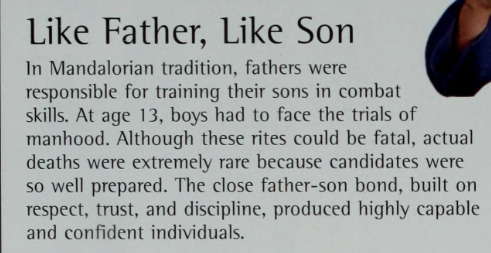
Like Father, Like Son In Mandalorian tradition, fathers were responsible for training their sons in combat skills. At age 13, boys had to face the trials of manhood. Although these rites could be fatal, actual deaths were extremely rare because candidates were so well prepared. The close father-son bond, built on respect, trust, and discipline, produced highly capable and confident individuals.
[9] The presented frame with Ko Sornell's family forgot include the small baby presented in issue #2 (the frames as reference were included in the analysis). Considering the mentioned baby and how the daughter is much smaller than the son at least in the one frame we see the kids close-up,

I think it is safe to assume there were two younger children most likely left under father's care while Ko Sornell was raiding the basilisk droid with her son (and three kids to take care of when Ko was far away for at least few days).
#star wars#cienie's take on mandalorian culture#arasuum#kad ha'rangir#mandalorian culture#mandalorian religion#I’m fully aware that Mandalorians: People and Culture (2006) predates a great number of tie-in material. that expanded our knowledge about#but it was important to establish how outdated the article is from the perspective of time.#i tend to see M:PaC as a good start into basic idea of culture but told from the perspective of modern mandalorians#while the knowledge about ancient times may be misinterpreted by “modern narrator”#also trust me to write a long post and add another wall of sidenotes lol#i know i'm pretty critical to KT's take on gender norms and some aspect of mando culture but the focus on father-son bonds#may be in fact influenced by earlier estabilished informations#but then taungs are pretty much ignored by the author when the religion definitely was affected by taungs
5 notes
·
View notes
Text
a list of my current sons:
-bill kaulitz
-swiss ghoul
-mikey way
-FRANCIS ABERNATHY
(the thing is certain ppl I love give off ‘son’ energy and others don’t)
for example I love gerard way as my wife and frank iero as a rat bastard spawn of satan
#bill kaulitz#gender envy but my baby 2000s him is so tiny#Swiss ghoul#um he is just#my son#uh#alastor hazbin hotel#is so girly pop and I love him#mikey way#um he’s just so son material like in the bullets era#ray toro#gets an honourable mention because he is the sweetest most amazing man in the whole wide world but I think he’s more father than son yk#mcr#ghost#hazbin hotel#Tokio Hotel
10 notes
·
View notes
Text
[Left behind] 𝟚 of 𝟚.
𝓨𝓸𝓾 𝓐𝓻𝓮... 𝓛𝓲𝓴𝓮... 𝓐 𝓗𝓾𝓶𝓪𝓷...
#Aoi Takumi#blog#my audio#NEOWIZ#ROUND8 STUDIO#Lies Of P 2023#Lies Of P#2023#game#Deluxe Edition#license version#PC#Romeo#your friend#/#𝓟 -has- the memories nominally ~ but he is a separate organism -consuming- human interactions/emotions/habits &#therefore coming closer to being alive ~ this echoes inside of him x 𝓟 transforms / he apparently perceives his Creator as a Father ~#not 'cause he feels like the Carlo ~ but because the man made the puppet's existence possible x he treats him well... treats him like a son#~ this is how I draw the picture ~ we are us#//#*reading some -expert Wiki/Reddit material- [whatever] ain't my cup of tea* &#𝕥𝕙𝕖𝕣𝕖 𝕨𝕚𝕝𝕝 𝕓𝕖 𝕟𝕠 𝕥𝕦𝕣𝕟𝕤 𝕚𝕟 𝕥𝕙𝕖 𝕞𝕒𝕥𝕥𝕖𝕣 𝕥𝕚𝕝𝕝 𝕥𝕙𝕖 𝕖𝕟𝕕
12 notes
·
View notes